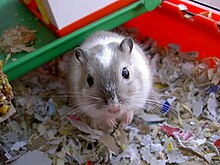
Back عضلان (فصيلة فرعية) Arabic عضلان ARZ Пясчанкі Byelorussian Jerbus petits Catalan Pískomilové Czech Хăйăртак CV Rennmäuse German Γερβιλίνες Greek Gerbillinae Spanish Liivahiir Estonian
| Gerbil Temporal range: Late Miocene – Recent
| |
|---|---|

| |
| Scientific classification | |
| Domain: | Eukaryota |
| Kingdom: | Animalia |
| Phylum: | Chordata |
| Class: | Mammalia |
| Order: | Rodentia |
| Family: | Muridae |
| Subfamily: | Gerbillinae Gray, 1825 |
| Genera | |
Gerbillinae is one of the subfamilies of the rodent family Muridae and includes the gerbils, jirds, and sand rats. Once known as desert rats, the subfamily includes about 110 species of African, Indian, and Asian rodents, including sand rats and jirds, all of which are adapted to arid habitats. Most are primarily active during the day, making them diurnal[1] (but some species, including the common household pet, exhibit crepuscular behavior), and almost all are omnivorous.
The gerbil got its name as a diminutive form of "jerboa", an unrelated group of rodents occupying a similar ecological niche. Gerbils are typically between 150 and 300 mm (6 and 12 in) long, including the tail, which makes up about half of their total length. One species, the great gerbil (Rhombomys opimus), originally native to Turkmenistan, can grow to more than 400 mm (16 in). The average adult gerbil weighs about 70 grams (2+1⁄2 ounces).
One species, the Mongolian gerbil (Meriones unguiculatus), also known as the clawed jird, is a gentle and hardy animal that has become a popular small house pet. It is also used in some scientific research.
- ^ "Gerbillinae (gerbils, jirds, and relatives)". Animal Diversity Web. Retrieved 3 June 2018.